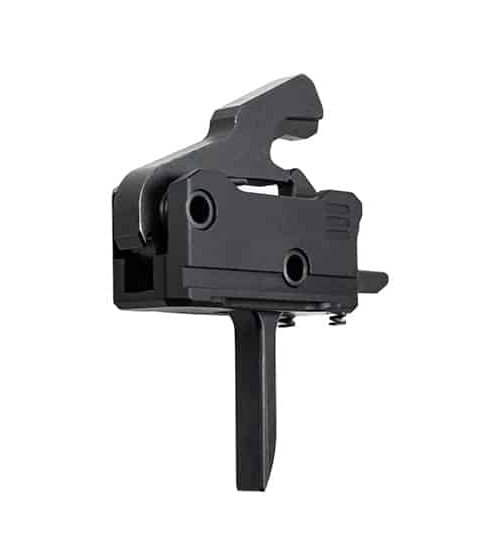SPECS, INFO, FAQ
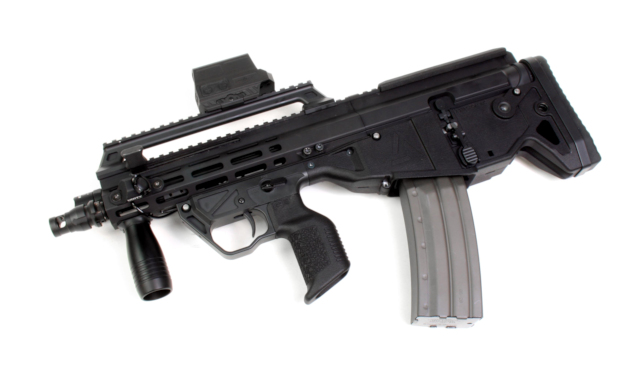
Updated - 11/25/2023
The TRIAD is our Modular Bullpup Chassis (MBC) based around a Mil-spec AR lower receiver. The Mil-spec receiver simply installs into the TRIAD chassis, and then a complete upper receiver is pinned in place, just like an AR. The primary difference being, the TRIAD uses new generation bufferless upper receivers. Currently, at the time of this writing, there are 4 major companies manufacturing compatible bufferless upper receivers: Foxtrot Mikes, Palmetto State Armory, Brownells, and Matador Arms. CMMG Dissent and FAXON ARAK-21 Variants in the works!
Scroll to the bottom for our FAQ section.
|
WHY A BULLPUP? There are many advantages to Bullpups over traditional rifle platforms:
For comparison, both firearms in the image to the right have a 16" barrel. Immediately noticeable is the distinct length difference between the two. Both have the triggers and butt-plate lined up equally, yet the Bullpup is 9.75" shorter overall with the same barrel length.
|
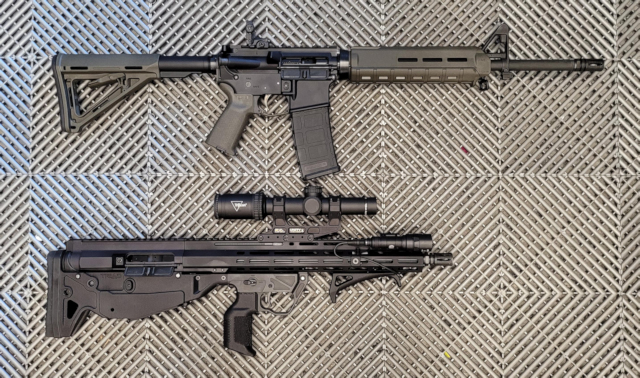 |
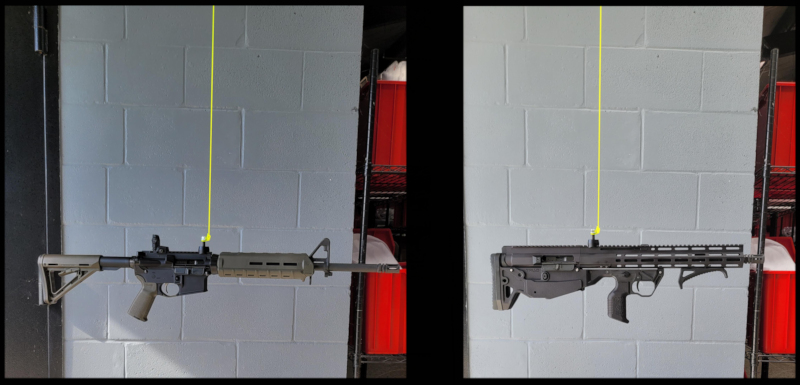
Center of mass - Both guns in the image above use AR-based barrels and similar recoil systems. The bolt and barrel generally represent the heaviest parts of a firearm. Bullpups relocate this mass rearward, better balancing the firearm and moving the center of gravity behind the shooters hand. To illustrate this visually, both configurations were hung from a point that balanced the firearm horizontally level. This balance point represents their center of gravity. As you can see, the standard AR configuration has the weight centered well forward of the grip, while the Bullpup configuration is actually behind the grip. Keep in mind that adding optics and a full magazine to both of these guns will only further validate this point.
While this visualization aids in understanding the physics of the comparison, actually holding the firearm, firing it, and performing general maneuvers with the gun quickly points out just how much of a difference moving that weight rearward actually makes. In many instances this weight relocation completely neutralizes muzzle rise while firing.
|
WHY AN AR? The reasons are countless. AR's are versatile, well proven, and have a very strong aftermarket. Their 2-part receiver and Modular features allow enthusiasts to upgrade and modify their firearms easily, and with endless possibilities. With the vast assortment of aftermarket parts and accessories available, AR–style rifles have been referred to as "the Swiss Army knife of rifles" or "LEGOs for adults". This popularity has led to an excess of over 20 million AR's in the states alone. Despite the adaptability and popularity of the AR platform throughout the years, there was always one feature of the design that made it a poor candidate for a Bullpup conversion - the fixed buffer tube and buffer system on the rear end of the receiver. This feature adds considerable length to the rear of the AR and is necessary to the operation of the firearm. In 2019 Brownells came out with their BRN-180 complete upper receiver assembly. This upper has a piston driven system which no longer needs the buffer tube and buffer assembly. A few years later Foxtrot Mike and Palmetto State Armory also released their versions of the bufferless upper receiver. With these new upper receivers now commonly available, the AR is finally a viable Bullpup candidate, and the system works remarkably. UPPER RECEIVERS: If you are new to AR15's, it is important to note that the upper receiver is traditionally not a serialized part so manufacturers can generally ship them direct to your door. They also utilize quick-pins which easily allows users to quickly swap upper receivers. This means you can switch from a 16" long 5.56 x 45 upper assembly to a 10.5" 300 BLK upper in a matter of seconds. Between the 3 main suppliers of upper receivers, you can currently run 5.56 x 45, 300 BLK, and 7.62 x 39 calibers with the Triad platform. More calibers are in the works, and there are also various barrel lengths available. See more details about barrel lengths and calibers below.
LOWER RECEIVERS: The AR has a relatively compact lower receiver that houses most of the operational controls and magwell. It is traditionally the only serialized part of the firearm. The standard Mil-spec receiver (which is necessary for this conversion) is light yet strong, inexpensive, and very plentiful - an ideal combination. They are also available as un-serialized 80% lowers, which opens up a lot of options if you have the ability to finish machining the lower yourself. Additionally, many already have registered Short-Barreled Rifles (SBR's) that they can use to convert over to Bullpups if they want to. Since the platform is so popular, you can get caliber-specific magazines for 5.56 x 45, 300 BLK, and 7.62 x 39. Additionally, there are magwell inserts that allow you to use Glock and Colt 9mm magazines in a Mil-spec lower. The options go on and on. |
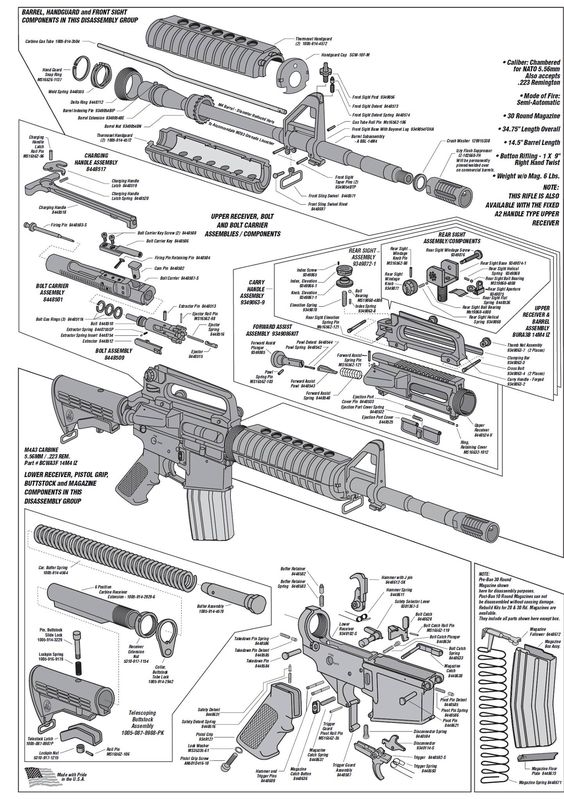 |
|
CALIBER OPTIONS, BARREL LENGTHS, ETC. As of this writing (6/12/2023), with currently available uppers and parts, we have proven 4 different calibers to work with the TRIAD - 5.56 x 45, 300 BLK, 7.62 x 39, and 9mm. Below is a list of the manufacturers of the uppers, the available calibers and barrel lengths, and any additional parts necessary for the combination to work:
Due to differences in buffers, handguards, etc, each upper will require separate components to work with the TRIAD chassis, but the appropriate parts for your application will be bundled in the kit. For example, the Foxtrot Mike upper requires it's own type of rear buffer. The BRN-180 requires a specific handguard spacer. These are just an example of some of the differences but these components will be included, as well as available separately for the customer that wishes to run various uppers. The PSA JAK'L requires a low-profile handguard. These are available for all current barrel lengths offered by PSA. |
 |
|
SPECS AND LEGALITIES - PLEASE READ! Be advised that the 1934 National Firearms Act (“NFA”) and the 1968 Gun Control Act (“GCA”)regulates firearms to include their specific configurations (i.e. length, etc.). See DISCLAIMERS. It is your responsibility to ensure compliance with all federal, state, and local laws and regulations.
The GCA, 18 U.S.C. §§ 921(a)(7)-(a)(8) and § 921(a)(29), respectively, define “rifle,” “short-barreled rifle” and “handgun” to mean, in pertinent part:
The term “rifle” means a weapon designed or redesigned, made or remade, and intended to be fired from the shoulder and designed or redesigned and made or remade to use the energy of an explosive to fire only a single projectile through a rifled bore for each single pull of the trigger.
The term “short-barreled rifle” means a rifle having one or more barrels less than sixteen inches in length and any weapon made from a rifle(whether by alteration, modification, or otherwise) if such weapon, as modified, has an overall length of less than twenty-six inches.* * *
The term “handgun” means:
(A)a firearm which has a short stock and is designed to be held and fired by the use of a single hand”
27 C.F.R. §478.11, which implements the GCA, defines “pistol” as:
A weapon originally designed, made, and intended to fire a projectile(bullet) from one or more barrels when held in one hand, and having (a) a chamber(s) as an integral part(s) of, or permanently aligned with, the bore(s);and (b) a short stock designed to be gripped by one hand and at an angle to and extending below the line of the bore(s).
The NFA, 26 U.S.C. § 5845(a), defines “firearm” as:
(1) a shotgun having a barrel or barrels of less than 18 inches in length; (2)a weapon made from a shotgun if such weapon as modified has an overall length of less than 26 inches or a barrel or barrels of less than 18 inches in length; (3) a rifle having a barrel or barrels of less than 16 inches in length; (4) a weapon made from a rifle if such weapon as modified has an overall length of less than 26 inches or a barrel or barrels of less than 16inches in length; (5) any other weapon, as defined in subsection (e); (6) a machinegun; (7) any silencer (as defined in section 921 of title 18, United States Code); and (8) a destructive device. The term “firearm” shall not include an antique firearm or any device (other than a machinegun or destructive device) which, although designed as a weapon, the Secretary finds by reason of the date of its manufacture, value, design, and other characteristics is primarily a collector’s item and is not likely to be used as a weapon.
The NFA,26 U.S.C. § 5845(c), defines “rifle” as:
a weapon designed or redesigned, made or remade, and intended to be fired from the shoulder and designed or redesigned and made or remade to use the energy of the explosive in a fixed cartridge to fire only a single projectile through a rifled bore for each single pull of the trigger, and shall include any such weapon which may be readily restored to fire a fixed cartridge.
|
NOTE: Utilizing a 16-inch barreled upper on your TRIAD chassis will only create a 24.75 inch overall length. Our TRIAD chassis ships with two butt-plates: a standard compact butt-plate and a 1.5-inch extended butt-plate designed to bring the firearm up to 26.25 inch overall length. The following configurations are necessary to achieve a 26 inch (or plus) overall length with th TRIAD:
PISTOLS: Any configuration that is not in rifle configuration must be in pistol configuration or registered as a short-barreled rifle on the NFA registry – the NFRTR. A3 Tactical offers a pistol variant of the TRIAD. The pistol variant uses a featureless receiver end cap, no cheek rest, and rear facing sling mounting socket, all features to prevent shouldering the "pistol". In the 70's and 80's, there was a firearm called the Bushmaster Arm Pistol. This was a 5.56 x 45pistol designed as a compact firearm for pilots who got shot down in enemy territory. The Pistol version of the TRIAD is shown in comparison below, and features a receiver end cap without butt-pad, rear-facing sling mounts, no cheek rest, and sights positioned for one handed firing, similar to the Bushmaster.
|
|
|
|
|
LENGTH-OF-PULL (LOP) Length-of-pull (LOP) is the distance from the forward face of the trigger to the rear of the buttpad. A common concern for some is that Bullpups tend to have long length-of-pulls. Our standard LOP for the TRIAD is 14.25" with our compact butt-plate. If you need to run the 1.5" extended butt-plate mentioned above, it will put your LOP at 15.75". |
Below are the LOP's for the most commonly available Bullpups:
|
|
MIL-SPEC RECEIVER OPTIONS Will my receiver fit your chassis? While the TRIAD chassis is designed to accept Mil-spec receivers, there are a few things you should know about compatibility. We get questions all the time - "will this receiver fit in your chassis?". There are 1000's of companies now producing AR lower receivers, and they are available in polymer, forged aluminum, and billet aluminum. Mil-spec is your standard, run-of-the-mill AR forged receiver. There are millions of these out there and just about anytime you see an ad for a forged AR receiver, it's a Mil-spec. Most companies that sell Mil-spec receivers are buying raw forgings, finishing the machining process, and putting their logos and branding on them. These forgings traditionally have the same external dimensions. Since these are the most common and economical receiver, this is what we patterned our chassis to fit. Please note that there are now Mil-spec forgings that have large, integrated trigger guards. These will not fit the TRIAD. What about billet lowers? With all of the variations of aftermarket billet receivers, it is just not possible to make one chassis fit them all. Excessively flared magwells, large oversized trigger guards, extra material profiling, etc., makes all we've tested incompatible, And would have required a much bulkier chassis to accommodate. It is our recommendation to stick to a standard forged Mil-spec lower receiver. There is literally no reason to use a billet lower - they are more expensive, usually much bulkier, heavier, and just not necessary for this application. There are some beautiful billet lowers out there but it simply doesn't matter because it is covered up anyway.
|
As we test various receivers, we will add to the list of know compatibles. As mentioned, most company's receivers are just re-branded standard Mil-spec receivers anyway. So far, we have verified that the following work:
|
|
TRIGGER How's the trigger? This is a very popular question that we get asked all of the time. One of our primary goals with the TRIAD was to produce a Bullpup that did not have the dreaded "Bullpup trigger" feel. This prompted us to create an entirely new and innovative method of linking triggers. A linkage without drag, without flex, and without excess movement or travel. We do not use a traditional trigger bar, or trigger rods like some Bullpups such as the PS90 and AUG utilize. Trigger bars/rods create a straight, linear pull-back trigger that does not feel natural, compared to traditional pivoting/rotating triggers. Straight, pull-back triggers and bars are a simpler and more economical approach for linkages but they have their drawbacks. They typically need to be either substantial in size, to remain rigid along the entire length, or they require a lot of guides to resist flex, or sometimes both even. This creates a heavier and sometimes bulkier connection between the 2 internal triggers. Heavy and bulky are never good terms for firearm parts, especially when it comes to describing trigger components. The extra linkage weight and additional friction from guides can contribute to added trigger pull weight, and even gritty, inconsistent trigger pulls if the guides are not maintained/lubed. We routinely shoot suppressed, and if you have experience with this, you know how much it soots up the inside of your firearm. Exposed internal guides for sliding linkages are susceptible to fouling, resulting in potential trigger issues. Nevertheless, trigger bars do work, and are the simplest, most cost-effective way to connect the triggers, however we wanted something better for the TRIAD. So how exactly did we do it? We use a traditionally designed, pivoting front trigger in combination with a bell crank to convert the "pull" movement from the forward trigger to a "push" movement for the rear trigger. This pull/push movement conversion allows the use of a traditional feeling, rotating front trigger, instead of a trigger that simply slides rearward. This means that, just like all firearms with pivoting triggers, you can change the leverage and pull weight by simply adjusting where your finger rides on the trigger. The use of a bell crank also allows us to have a very short "push" linkage in the rear, eliminating the need for multiple guides, and also reducing linkage weight, bulk, and flex potential. The entire weight of our linkage is only 0.8 oz. Oil-impregnated bronze bushings are used at the pivot locations and all hinge points retain +.001/-.001" tolerances to provide virtually frictionless movement with minimal slop. We utilize a low-weight linkage return spring to hold a slight amount of tension on the linkage. This will add one pound of pull weight to your trigger. While this method is more complex and expensive, we feel the end result is worth it. By utilizing modern manufacturing methods such as MIM technology, we were able to offset some of these costs, while actually improving strength and reducing weight. And to top it all off, all TRIADS ship with a Rise Armament RAVE 140 drop-in trigger included! The RAVE 140 has a smooth, crisp break and a very short reset. They have a 3.5 lb. pull weight which yields a 4.5 lb. pull weight in the TRIAD. The result is a Bullpup trigger unlike any other. |
|
|
MATERIAL COMPOSITION Only the best materials comprise the TRIAD chassis:
|
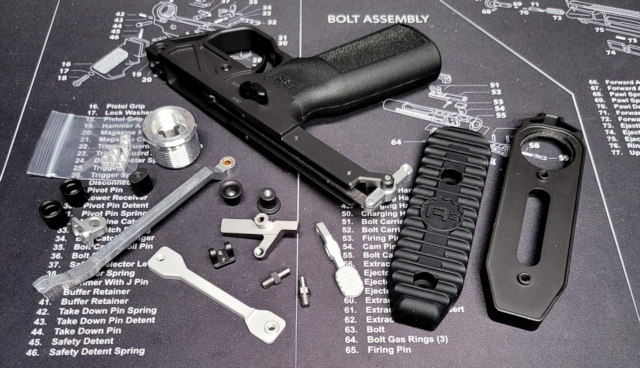 |
|
ACCESSORIES AND SPARE PARTS We will have a full line of add-on accessories for your TRIAD. Currently releasing at the same time will be our Modular Rail risers, a line of angled foregrips designed to fit the contours of the TRIAD front trigger module, and a front lower handguard for 16" barreled uppers. For those building SBR's with really short barrels, we will also have a TRIAD-specific Vertical front grip with hand-stop. A complete line of spare parts will also be available at the same time we release the chassis. The TRIAD chassis will be an evolving product as well. The modular design allows us to re-configure components for new applications. As more calibers, barrel lengths, and new uppers are released, we plan to make whatever changes, add-ons, or updates necessary to ensure compatibility. |
 |
FAQ's
Please see our frequently asked questions below. We will continue to update this section but if you have additional questions not covered below, please reach out to tech@a3tactical.com.
Is the TRIAD considered a lower receiver? No. The TRIAD is simply a chassis. It houses a Mil-spec AR lower receiver (supplied by by the user) internally. AR lower receivers are the serialized part of an AR and would be considered the lower receiver.
Does the TRIAD need to be transferred to an FFL? No. Since the TRIAD is simply a chassis, it is considered an un-regulated accessory, and we can ship it directly to your door-step.
What else do I have to buy to make the TRIAD a complete firearm? You will need to purchase a standard Mil-spec receiver, a bolt catch (with spring, pin, and plunger), and a bufferless upper receiver assembly. No AR parts kit is necessary, as we provide all of the internals and assembly components. See below for lower receiver, and upper compatibility.
Which lower receivers are compatible? You will need a standard, no frills, Mil-spec lower receiver. These are by far the most common and least expensive receiver available . No receivers with integrated trigger guards. Integrated trigger guards swell downward, which would have required a taller chassis to accommodate. No billet receivers. There are simply too many companies making their own billet lower receivers. Most manufacturers have their own unique external features to distinguish them from the rest, and these are all in critical areas that keep the chassis slim. Compatibility would have required a much bulkier chassis to accommodate. Most of these features are cosmetic anyway and since they won't be seen inside the chassis, there is simply no reason to run a billet lower receiver in the TRIAD.
Which upper receivers are compatible? The TRIAD requires the use of a bufferless upper receiver. Traditional AR upper receivers utilize a rear buffer tube, buffer spring, and buffer. These components are necessary to the functionality of a traditional AR upper receiver. There are now some AR upper receivers manufactured that house the entire recoil assembly in the upper receiver, and do not require the use of a buffer tube. Manufacturers of these uppers include Foxtrot Mikes, Palmetto State (JAK'L), and Brownells (BRN-180). Additionally we have tested and approved the 9MM upper by Matador Arms. Please note that some of these uppers come in various calibers. Please see the caliber section below for details.
What triggers are compatible? All TRIAD's will ship with a Rise Armament RAVE 140 drop-in straight trigger. These have been thoroughly tested with this system and work remarkably. With a 4.5 lb. pull weight, short reset, and clean break, there really is no reason to run anything else. That being said, just about any single-stage trigger will work, although re recommend straight triggers as they work best with the internal linkage interface. We do not recommend 2-stage triggers.
How difficult is it to assemble the TRIAD? Assembly is very straightforward and simple, with supplied wrenches and instructions. The only tool necessary that does not come with the kit is a 3/8" drive ratchet. The chassis comes pre-assembled with the linkage self-contained, adjusted and tested. The user simply removes the left side chassis half and inserts their bare AR receiver with pre-installed trigger and bolt catch. The chassis half is re-installed then the user adjusts the trigger actuator. With the chassis back together, the user then installs either the end cap (pistol) or butt-plate (rifle). The final part of the installation is mounting the M-LOK front takedown lug on the upper receiver. The entire installation process can easily be accomplished in a half hour, and much less once you have done it and understand the process. If you want to see what it takes to build a TRIAD, you can see our online instructions HERE.
What is the Length-of-Pull (LOP)? In it's standard configuration, the LOP is 14.25". If you are using our 1.5" buttpad spacer, the LOP is 15.75". See "SPECS AND LEGALITIES" above for more details on how overall length restrictions can play a part on LOP.
How much does the TRIAD weigh? A standard rifle configuration using our TRIAD chassis and a Foxtrot Mikes 16" upper weighs 6 lbs, 8 oz. with no optic or accessories. As a comparison to other popular Bullpups, the Steyr AUG and IWI Tavor X95 both weigh 7 lbs., 9 oz. The Springfield Armory Hellion weighs 8 lbs.
What is the overall length of the TRIAD with a 16" barreled upper? The length from end of barrel (not muzzle brake) to the rear of the buttpad is 24.75". Please see above information for "OVERALL LENGTH".
Can I swap back and forth from my Foxtrot Mikes, PSA Jak'l, and BRN-180 upper? Yes, and no. If you have all one brand upper then you can easily swap all of them without changing anything. For instance, if you have a 16" Foxtrot Mikes upper and a 12.5" Foxtrot Mikes upper, you can swap them back and forth with no changes whatsoever. Unfortunately, the Jak'l and FM uppers use completely different internal buffers that are not compatible, so those uppers cannot be interchanged without a dedicated TRIAD lower (unless the internal buffers are swapped). The BRN-180 uppers can be swapped onto the TRIAD Jak'l lowers and will function perfectly fine, but you will have a gap between the handguard and lower, since the BRN-180 handguard is so much smaller than the Jak'l handguard.
Can I make one TRIAD chassis work with every available upper? Yes. The TRIAD chassis by itself is the same for all applications. The parts that make our kits unique to the upper are items such as internal buffers, front takedown lugs, and trigger housing caps. All of these components are available to purchase individually so that you can re-configure your TRIAD for whatever variety of uppers you have. Available on the TRIAD ACCESSORIES PAGE (Launching soon).
If I purchase the TRIAD pistol, can I upgrade to a butt-plate when my Form 1 stamp gets here? Yes. We have a butt-plate upgrade kit that consists of a lower butt-plate support, buttplate, 1.5" extended butt-plate, buttpad, and all mounting hardware. Available on the TRIAD ACCESSORIES PAGE (Launching soon).
What calibers can I use in the TRIAD? We have successfully tested 5.56 x 45, 300BLK, 7.62 x 39, and 9mm in the TRIAD. Please note however that 7.62 x 39 only works with the BRN-180 upper because it uses traditional AR-based ASC/Duramag magazines. The PSA Jak'l upper in 7.62x39 requires standard AK-based roll and lock magazines which are not compatible with this chassis.
Where can I order a TRIAD? You can order your TRIAD at the following link: https://a3tactical.com/triad-modular-bullpup-chassis/
Click for TRIAD DISCLAIMER

 US Dollar
US Dollar



